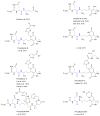Natural products as mediators of disease
- PMID: 27874907
- PMCID: PMC5299058
- DOI: 10.1039/c6np00063k
Natural products as mediators of disease
Abstract
Covering: up to 2016Humans are walking microbial ecosystems, each harboring a complex microbiome with the genetic potential to produce a vast array of natural products. Recent sequencing data suggest that our microbial inhabitants are critical for maintaining overall health. Shifts in microbial communities have been correlated to a number of diseases including infections, inflammation, cancer, and neurological disorders. Some of these clinically and diagnostically relevant phenotypes are a result of the presence of small molecules, yet we know remarkably little about their contributions to the health of individuals. Here, we review microbe-derived natural products as mediators of human disease.
Figures




Similar articles
-
The insect microbiome is a vast source of bioactive small molecules.Nat Prod Rep. 2024 Jun 19;41(6):935-967. doi: 10.1039/d3np00054k. Nat Prod Rep. 2024. PMID: 38411238 Review.
-
Thinking big about small beings--the (yet) underdeveloped microbial natural products chemistry in Brazil.Nat Prod Rep. 2014 May;31(5):646-75. doi: 10.1039/c3np70112c. Epub 2014 Apr 2. Nat Prod Rep. 2014. PMID: 24691682 Review.
-
Predicting biochemical and physiological effects of natural products from molecular structures using machine learning.Nat Prod Rep. 2021 Nov 17;38(11):1954-1966. doi: 10.1039/d1np00016k. Nat Prod Rep. 2021. PMID: 34047331 Review.
-
Recent advances in gut microbiota-associated natural products: structures, bioactivities, and mechanisms.Nat Prod Rep. 2023 Jun 21;40(6):1078-1093. doi: 10.1039/d2np00075j. Nat Prod Rep. 2023. PMID: 37013809 Review.
-
HUMAN MICROBIOTA. Small molecules from the human microbiota.Science. 2015 Jul 24;349(6246):1254766. doi: 10.1126/science.1254766. Epub 2015 Jul 23. Science. 2015. PMID: 26206939 Free PMC article. Review.
Cited by
-
The Role of Oral Microbiota in Intra-Oral Halitosis.J Clin Med. 2020 Aug 2;9(8):2484. doi: 10.3390/jcm9082484. J Clin Med. 2020. PMID: 32748883 Free PMC article. Review.
-
Biosynthesis of the Enterotoxic Pyrrolobenzodiazepine Natural Product Tilivalline.Angew Chem Int Ed Engl. 2017 Nov 13;56(46):14753-14757. doi: 10.1002/anie.201707737. Epub 2017 Oct 18. Angew Chem Int Ed Engl. 2017. PMID: 28977734 Free PMC article.
-
Phytochemicals in Drug Discovery-A Confluence of Tradition and Innovation.Int J Mol Sci. 2024 Aug 13;25(16):8792. doi: 10.3390/ijms25168792. Int J Mol Sci. 2024. PMID: 39201478 Free PMC article. Review.
-
Nonribosomal peptide synthetase biosynthetic clusters of ESKAPE pathogens.Nat Prod Rep. 2017 Aug 2;34(8):981-1009. doi: 10.1039/c7np00029d. Nat Prod Rep. 2017. PMID: 28642945 Free PMC article. Review.
-
Microbial lipases and their industrial applications: a comprehensive review.Microb Cell Fact. 2020 Aug 26;19(1):169. doi: 10.1186/s12934-020-01428-8. Microb Cell Fact. 2020. PMID: 32847584 Free PMC article. Review.
References
-
- Carter GT. Nat Prod Rep. 2011;28:1783–1789. - PubMed
-
- Harvey AL, Edrada-Ebel R, Quinn RJ. Nat Rev Drug Discov. 2015;14:111–129. - PubMed
-
- Newman DJ, Cragg GM. Journal of natural products. 2016;79:629–661. - PubMed
-
- Challinor VL, Bode HB. Annals of the New York Academy of Sciences. 2015;1354:82–97. - PubMed
Publication types
MeSH terms
Substances
Grants and funding
LinkOut - more resources
Full Text Sources
Other Literature Sources

